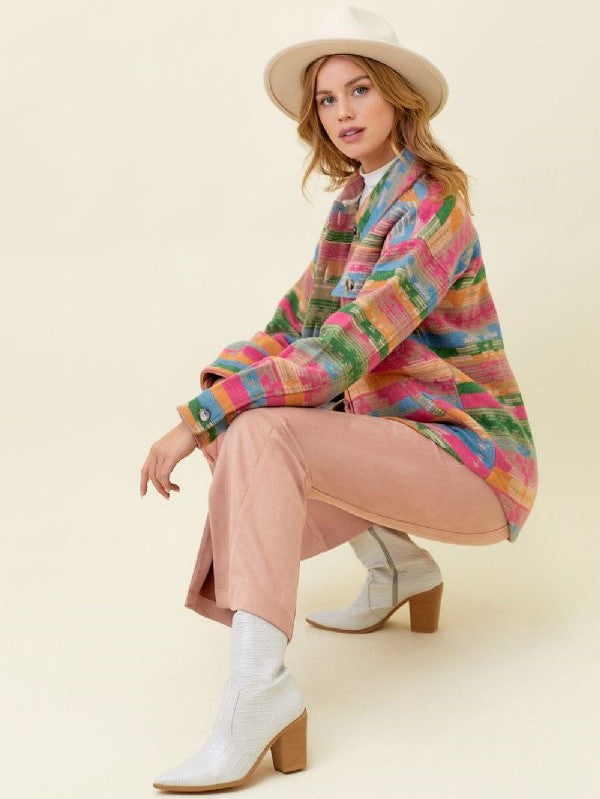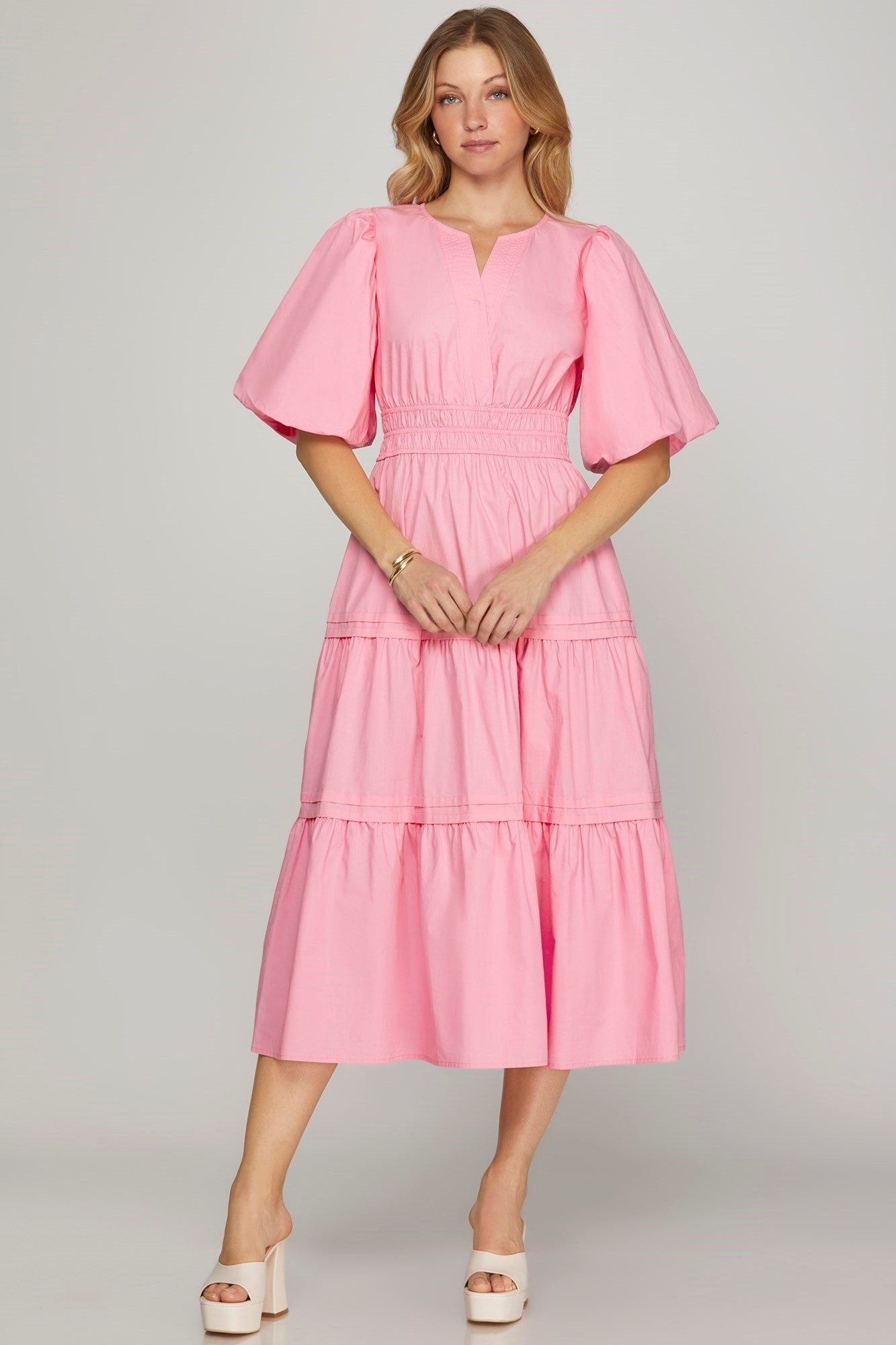Texture is fashion's secret weapon for creating sophisticated, visually compelling outfits that feel expensive and thoughtfully curated. While color and silhouette often get the spotlight, texture adds depth, dimension, and tactile appeal that can transform even the simplest outfit into something extraordinary. Understanding how different materials interact, complement, and contrast with each other opens up endless possibilities for creating outfits that are both visually interesting and authentically stylish.
Understanding Texture Categories
Smooth Textures create sleek, polished appearances that reflect light beautifully. The Satin Tiered Maxi Dress exemplifies this category with its lustrous surface that catches and reflects light, creating an inherently elegant and sophisticated look. Smooth textures work particularly well for formal occasions and professional settings.
Rough Textures add visual weight and tactile interest to outfits. Think tweeds, bouclés, and textured knits that create shadow and depth. These textures often feel more casual and approachable while adding sophistication through their complexity.
Structured Textures maintain their shape and form, creating architectural interest in outfits. Pieces like the Andie Crosshatch Jacquard Dress demonstrate how structured textures can add visual complexity while maintaining clean, sophisticated lines.
Flowing Textures move naturally with the body, creating soft, romantic effects. These materials drape beautifully and often feel more feminine and ethereal in their presentation.
The Science of Texture Perception
Our brains process texture information both visually and through anticipated touch, meaning we "feel" textures even before we touch them. This psychological response influences how we perceive sophistication, luxury, and quality in clothing. Understanding these responses helps you choose texture combinations that create the impression you want to make.
Visual Weight: Different textures carry different visual weights. Smooth, shiny textures tend to appear lighter and more formal, while rough, matte textures appear heavier and more casual. Balancing these weights creates harmonious, well-proportioned looks.
Light Interaction: How textures interact with light dramatically affects their appearance. Shiny textures reflect light and can make areas appear larger, while matte textures absorb light and can create slimming effects.
Mastering Smooth and Rough Combinations
One of the most effective texture mixing techniques involves pairing smooth and rough materials to create compelling contrast. The Deuce Dolman Waffle Knit Top offers an interesting rough texture that would pair beautifully with smooth bottoms like silk pants or a sleek leather skirt.
This combination works because it creates visual dialogue between different surface qualities. The smooth element provides sophistication and polish, while the rough element adds interest and prevents the outfit from feeling too precious or untouchable.
Styling Tips: When combining smooth and rough textures, consider which element you want to dominate. A rough-textured blazer over a smooth silk blouse creates a different effect than a smooth blazer over a textured knit top.
Hard and Soft Texture Interplay
Hard Textures include leather, structured cotton, and crisp fabrics that maintain their shape. Soft Textures encompass flowing fabrics, knits, and anything that drapes naturally. The Textured Lace V-Neck Top demonstrates how soft, delicate textures can add femininity and romance to an outfit.
Combining hard and soft textures creates sophisticated contrast that feels both structured and approachable. A leather jacket over a flowing dress, or structured pants with a soft knit top, exemplifies this principle.
Balance Considerations: When mixing hard and soft textures, pay attention to proportion. Too much hard texture can feel severe, while too much soft texture might lack structure. The goal is creating harmonious balance that serves your style goals.
Shiny and Matte Combinations
The interplay between reflective and non-reflective surfaces creates some of fashion's most sophisticated looks. Shiny textures like satin, silk, or metallic fabrics naturally draw attention and create focal points, while matte textures provide grounding and sophistication.
Strategic Placement: Use shiny textures where you want to draw attention and matte textures where you want to create calm, sophisticated balance. A matte blazer with a satin blouse, or matte pants with a silk top, demonstrates this principle effectively.
Seasonal Considerations: Shiny textures often feel more appropriate for evening or special occasions, while matte textures work beautifully for daytime and professional settings. However, subtle shine can work in professional environments when balanced with matte elements.
Layering Different Textures
Successful texture layering requires understanding how different materials interact when worn together. Some textures naturally complement each other, while others create friction or bulk that can be unflattering.
Compatible Combinations: Smooth textures layer well under structured pieces, while soft knits work beautifully over fitted base layers. The Floral Embroidered Lace Top W/Fringe Detail could layer beautifully over a smooth camisole, creating textural interest without bulk.
Avoiding Texture Clash: Some textures compete for attention or create unflattering bulk when combined. Heavy knits over other heavy textures, or multiple shiny textures together, can create visual overwhelm rather than sophisticated layering.
Fabric-Specific Texture Strategies
Cotton Textures: Cotton comes in numerous textures, from smooth poplin to rough canvas. The Balloon Half Sleeve Poplin Midi Dress W/Pockets showcases cotton's crisp, structured texture that works beautifully with both smooth and rough complementary textures.
Knit Variations: Different knit structures create vastly different textural effects. The Heart Knit Puff Sleeve Top W/Stripe Trim demonstrates how decorative knit patterns can add visual interest while maintaining comfort and wearability.
Lace and Eyelet: These textures add feminine detail and visual lightness to outfits. The Eyelet Open Back Maxi Dress shows how eyelet texture creates sophisticated detail that feels both structured and romantic.
Embellished Textures: Embroidery, appliqués, and other surface decorations create textural interest that can serve as focal points in outfits. The 3D Floral Applique Mini Dress W/Tie Straps demonstrates how dimensional textures can create stunning visual impact.
Color and Texture Interactions
Color and texture work together to create overall visual impact. Light colors in smooth textures can appear ethereal and delicate, while the same colors in rough textures feel more substantial and grounded.
Monochromatic Texture Play: Using different textures in the same color family creates sophisticated, cohesive looks with plenty of visual interest. This approach allows texture to be the star while maintaining color harmony.
Contrasting Color Textures: Pairing contrasting colors in different textures can create dynamic, eye-catching combinations. However, this approach requires careful balance to avoid visual overwhelm.
Seasonal Texture Considerations
Spring Textures: Light, fresh textures like cotton poplin, linen, and soft knits feel appropriate for spring's renewal energy. These textures should feel clean and optimistic.
Summer Textures: Focus on breathable, lightweight textures that don't retain heat. Smooth cottons, linen, and flowing fabrics work beautifully for summer styling.
Fall Textures: Richer, more substantial textures like tweeds, corduroys, and heavier knits feel appropriate for fall's cozy atmosphere. These textures can handle more complexity and visual weight.
Winter Textures: Luxurious textures like cashmere, wool, and velvet feel appropriate for winter's formal season. These textures should feel rich and substantial.
Professional Texture Mixing
In professional settings, texture mixing should be subtle and sophisticated. Avoid textures that are too casual or attention-grabbing, and focus on combinations that enhance rather than distract from your professional presence.
Conservative Approaches: Stick with subtle texture variations within professional-appropriate materials. A textured blazer with smooth pants, or a smooth blouse with textured skirt, provides interest without being distracting.
Creative Professions: Those in creative fields can experiment more boldly with texture combinations, using them to express personality while maintaining professionalism.
Care and Maintenance Considerations
Different textures require different care approaches, which affects how you can realistically combine them in your wardrobe. Consider care requirements when building texture-mixed outfits to ensure longevity and continued good appearance.
Fabric Compatibility: Some texture combinations may cause pilling, snagging, or other wear issues when worn together regularly. Choose combinations that will maintain their appearance over time.
Cleaning Coordination: Pieces that are frequently worn together should have compatible care requirements for practical maintenance.
Building a Textured Wardrobe
Foundation Pieces: Start with versatile textured pieces that work well with multiple other textures. Smooth blouses, textured blazers, and well-made knits provide excellent foundations for texture mixing.
Statement Textures: Include a few pieces with interesting textures that can serve as focal points in outfits. The Rosette Jacquard Mini Dress represents this type of statement texture piece.
Transitional Textures: Have pieces that bridge different texture categories, allowing you to create smooth transitions between very different textural elements.
Common Texture Mixing Mistakes
Too Much Texture: Overloading an outfit with multiple competing textures can create visual chaos rather than sophisticated interest. Start with one or two texture contrasts and build from there.
Ignoring Proportion: Different textures have different visual weights that affect overall outfit proportions. Consider how textural choices impact your silhouette.
Forgetting Function: Beautiful texture combinations that don't work practically for your lifestyle won't serve you well. Choose combinations that look great and function well for your daily activities.
Mastering texture mixing takes practice and experimentation, but the results are worth the effort. Texture adds sophistication and visual interest that can make even simple outfits look expensive and thoughtfully curated. Start with subtle combinations and gradually build confidence in mixing more contrasting textures.
Remember, the goal isn't to use as many textures as possible, but to choose combinations that create the aesthetic and emotional impact you're seeking. Whether you're drawn to the subtle sophistication of similar textures or the dramatic impact of contrasting ones, understanding texture gives you another powerful tool for creating authentic, compelling personal style.





